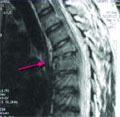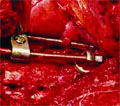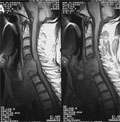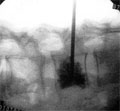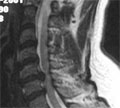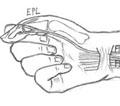The eLitMed.hu medical portal uses computer cookies for convenient operation. Detailed information can be found in the Cookie-policy.
Clinical Neuroscience - 2003;56(01-02)
Content
[Changes in the approach and the methods in acute surgical treatment of severe thoraco-lumbar spinal injuries]
[The authors show the changes in the approach and methods concerning the acute surgical treatment of severe thoracolumbar spinal injuries. In the past 15 years, 878 acute surgical treatments have been done with ventral-, dorsal or combined method. The results are evaluated from the point of view of neurological function recovery, bony union, restoration of patients' comfort and complications. Authors discuss the changes of past 15 years regarding the basic ideas of the treatment of spinal injuries, the indications and methods of modern surgical techniques. The use of new surgical methods which are closely connected to the biomechanical characteristics of the injured spine are stressed, as well as the importance of the primary definitive ventral surgical treatment, in the case of a severe thoraco-lumbar spine injury.]
[Spinal stabilizations in our department 1989-2002]
[With the aim to compare results to those found in the literature, authors present a retrospective overview of the spinal stabilisations carried out in the Neurosurgical Department at the St. John’s Hospital, Budapest, Hungary between 1989 and 2002. This 37 bed department provides neurosurgical services to the Buda region with its one million inhabitants. Out of 156 000 injuries in total in the past 13 years, the department has dealt with 9360 neurotraumatologic cases, 560 of them suffering from spinal injuries. In parallel, non-traumatic cases were also treated for tumour, infections, degenerative diseases and for the instability of the spine. The 224 stabilised cases were classified into three groups: cervical, thoracic, lumbar. The authors enumerate the type of operation in each level and they present the number of cases belonging to each type. Septic complications occured in 2.5% of cases. Screw breaking or slackening of the implanted devices was observed in 2% of the cases. The types of spinal operations applied provide satisfactory method for controlling the problems caused by the instability the spinal trauma, degenerative and tumourous cases. These results do not diverge from those found in the literature.]
[Surgical treament of sacro-coccygeal chordoma]
[Chordoma is an uncommon malignant tumor with unusual characteristics developing in the remnants of the notochord and usually manifesting itself in patients in their forties and fifties. It is usually located in the body's symmetrical axis or attached to it. The pathological structure is rather characteristic to benign tumors. Although not painful, it is a mercilessly aggressive local tumor, in some cases resulting metastatic progression and might alter its histological picture in longlived patients. It is found most prevalently (about 60 percent) in the sacrococcygeal region and at the clivus and manifesting itself spinally (over the sacrum) most likely in the lumbar region. Between 1992 and 2002, the authors have treated surgically 37 patients with sacrococcygeal chordoma. They applied wide resection following which only seven patients required re-operation. They show detailed data regarding this patient group and discuss the technical aspects of the wide tumorresection.]
[Primary intramedullary glioblastoma multiforme of the spinal cord: report of eight cases]
[Primary glioblastoma multiforme located intramedullary in the spinal cord is a very rare entity. The authors report eight cases and discuss the clinical features, the possibility of diagnosis, combinated treatment and pathomorphological signs focusing on the relevant literature and their experience.]
[Anterior and posterior stabilization following the resection of a thyroid gland tumor destroying more cervical segments]
[Case report - Authors report a case of thyroid gland carcinoma. The tumor had metastases into the CV-VI-VII vertebras. Through an anterior approach, they removed the malignant tumor together with the bodies of the affected cervical vertebras and a two stage combined (anterior and posterior) cervical instrumentation was performed. The anterior fusion was carried out with iliac crest bone grafting and plate fixation. After four years the patient is alive and well, without symptoms of tumor recurrence or neurologic deficiency. The ventral fusion is stable. Conclusions - Authors present a case of a successful operation of thyroid gland malignant tumor having metastatases in the CV-VI-VII vertebras. Tumor resection, fusion and instrumentation is suggested to be carried out in one stage. The anterior and posterior instrumentation is essential. Radical removal of the tumor is mandatory even with complex instrumentation and oncotherapy procedures.]
[Percutaneous-transpedicular acrylat vertebroplasty for treatment of lumbar vertebral hemangioma - case report]
[The authors present the management of a patient suffering from lumbar vertebral hemangioma. Percutaneous transpedicular acrylate vertebroplasty was performed. This method has widely been used for the treatment of pathological vertebral bodies of different aetiology. A brief rewiev of the literature of previous and current methods is presented. A detailed discussion is given why vertebroplasty was used in contrast to the radiological investigation where the patient's hemangioma proved to be a non-agressive type. According to the authors' knowledge this is the first Hungarian publication of acrylate vertebroplasty for the treatment of vertebral hemangioma.]
[Unusually located metastatic tumors of the spine]
[Metastatic spine tumors are representing a growing number of oncological patients. In this paper the authors would like to focus on a rare type of metastatic spine tumors, the unusually located ones. Since the advent of MRI and with the progress in general oncology this formerly rare tumors became more frequently recognized. Consequently these tumors are causing a new challenge for the oncologists, neurologists and neurosurgeons as well. The aim of the authors with this paper was to raise, especially the neurologists' attention to this emerging problem.]
[The value of motor evoked potentials in the diagnosis of spondylotic myelopathy]
[Introduction - Motor evoked potential (MEP) is the only method that is able to assess the function of the corticospinal tract in various neurological conditions, such as myelopathies. Myelopathy associated with cervical spondylosis, especially at an early stage, has often slight and non-specific clinical signs, pointing to the importance of the electrophysiological assessment of the spinal cord. The authors' aim was to investigate the sensitivity of MEP examination in the detection of myelopathy secondary to cervical spondylosis. Patients and methods - Patients were classified into three groups according to clinical signs and symptoms: Group I includes patients who have cervical spondylosis as demonstrated by MRI (narrowing of the spinal canal, discal herniation, spinal cord compression) but no complaints or signs suggestive of myelopathy. Results - In Group II patients had minor, non-specific complaints, such as paraesthesia of the legs and gait disturbance raising the possibility of myelopathy, but neurological examination revealed no pyramidal signs. In Group III patients had pyramidal signs as well. In Group I corticospinal function was normal in all patients, as assessed by MEP examination. In Group II all patients had prolonged central motor conduction time or absent responses to cortical stimulation. Likewise, in Group III MEP revealed abnormal corticospinal function in all patients but one. Conclusions - In summary, MEP proved sensitive in the detection of corticospinal dysfunction in myelopathy associated with cervical spondylosis at a stage when clinical signs of pyramidal lesion are not yet present and patients have only minor complaints. On the other hand, if patients are completely symptom free with regard to myelopathy, MEP is also unlikely to disclose corticospinal dysfunction. If pyramidal lesion is evident already by clinical examination, MEP provides no further help. ’Falsenegative’ results are also possible.]
[Operative treatment of pressure sores of the pelvic region in spinal cord-injured patients]
[by either conservative or surgical methods. Shortened healing period and long lasting results can be achieved by surgery. Between 1993 and 2001 the authors performed 64 operations with musculocutaneous or musculo-fasciocutaneous flaps in all cases. All patients healed primary except one, whose 20-year-old pressure sore transformed malignant and gave metastasis. The complication rate was 21.42%, that equals with the data of the literature. Measuring the late postoperative results by follow-up questionnaire, a 9.52% ratio of recurrence was found, which was significantly smaller than data of the literature (19-82%). Authors analyse the causes of their (good) results.]
[The role of reconstructive surgery for upper limbs in the rehabilitation of tetraplegia (case report)]
[As part of the rehabilitation of tetraplegical patients, movement improving operations have been carried out for more than 30 years. The scant results of the early 70's caused such a standstill and division among professionals, that operations on the upper limbs on tetraplegical patients became questionable. The authors started operating upper limb reconstructions on tetraplegia patients for achieving a basic hand function i.e. keypinch, grasping etc. in 2001. Three cases are quoted and one of them, operated ten months ago is described in details. The postoperative treatment of the other two patients has not finished yet. In 1998, a twenty-three years old girl had her fifth and sixth cervical vertebra broken in a car accident. The rugged break of the fifth vertebral body damaged the spinal chord. After the accident all four limbs became ataxic and a complete numbness occurred distally from the thoracic level of the chest. The patient went through a CV corpectomia, a corpus complementation, a CIV-V dissectomia and a CIV-VII ventrofixation. After the operation the movements of the upper limbs improved but those of the lower limbs did not. Her general condition stabilised after the treatments at the intensive care and the laryngological, the urological and the plastical surgery as well as the complex therapy at the rehabilitation department. She moved around in a wheelchair. After a para-coordinational treatment she was able to lift up small objects, but because of her paralysed bending and stretching finger muscles she was not able to hold heavier objects with her hands. In March 2002 a grip improving operation was carried on her dominant right hand. Twelve weeks after the operation she could lift up a weight of 2 kg and she was able to keypinch and grip with force.]
[The role of electrical neuromodulation in the therapy for chronic lower urinary tract dysfunction]
[The electrostimulation techniques may be used as a supplement or an alternative to standard therapy. Electrical therapy for chronic lower tract dysfunction comprises of noninvasive pudendal nerve neuromodulation and invasive sacral nerve stimulation. Short-term functional electrical stimulation seems favourable in selected patients with detrusor hyperreflexia. Sacral nerve stimulation may be a successful treatment option for patients with refractory detrusor overactivity and some forms of urinary retention.]
1.
Clinical Neuroscience
[Headache registry in Szeged: Experiences regarding to migraine patients]2.
Clinical Neuroscience
[The new target population of stroke awareness campaign: Kindergarten students ]3.
Clinical Neuroscience
Is there any difference in mortality rates of atrial fibrillation detected before or after ischemic stroke?4.
Clinical Neuroscience
Factors influencing the level of stigma in Parkinson’s disease in western Turkey5.
Clinical Neuroscience
[The effects of demographic and clinical factors on the severity of poststroke aphasia]1.
2.
Clinical Oncology
[Pancreatic cancer: ESMO Clinical Practice Guideline for diagnosis, treatment and follow-up]3.
Clinical Oncology
[Pharmacovigilance landscape – Lessons from the past and opportunities for future]4.
5.
